Now we'll enter a customer's remittance and allocate it.
Bring a customer up onto the Main Form.
Receive a Payment / remittance
Click this image to view a video of this topic:
| • | Select a customer onto the Main Form |
| • | From the Customer menu, choose Add Payment/Credit (CTRL-M) |
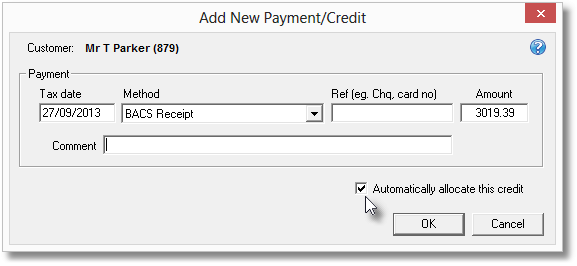
| • | Enter the payment details, choosing an appropriate 'Payment Method'. |
If you want the payment to appear on last month's statement, don't forget to back date the Tax Date.
| • | Click Ok |
That's it.
You may have noticed the ticked box 'Automatically allocate this credit'. Yes you've guessed it, Lab Manager has automatically allocated your credit to the customer's unpaid jobs. It's done on an oldest-first principle.
If you want to allocate the receipt to particular jobs/invoices, untick 'Automatically allocate..' before clicking Ok.
We'll do an example now.
Manually allocating a receipt to specific jobs
Click this image to view a video of this topic:
We'll assume a cheque for £60.32 is received from Mr Beresford (account 455) specifically to pay for a job (INV199507) for the patient Bentley.
| • | Select customer 455 / Beresford onto the Main Form |
| • | From the Customer menu, choose Add Payment/Credit (CTRL-M) |
| • | Fill in the payment details as usual. |
| • | Un-tick 'Automatically allocate this credit' |
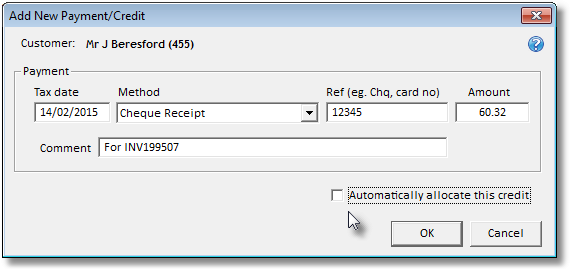
| • | Click Ok |
The allocations window will show the £60.32 as un-applied. We can 'spend' this money how we like now..
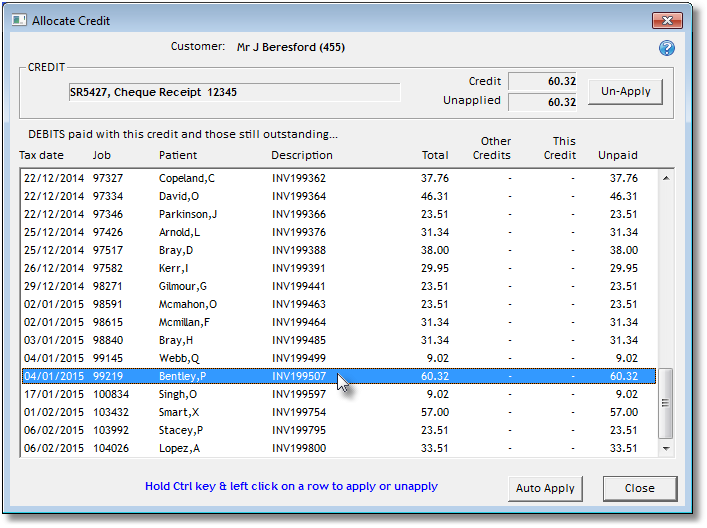
We want to apply this cheque to Job 99219 (INV199507) for patient Bentley.
| • | Hold down the CTRL key on your keyboard and click the job you wish to allocate credit to |
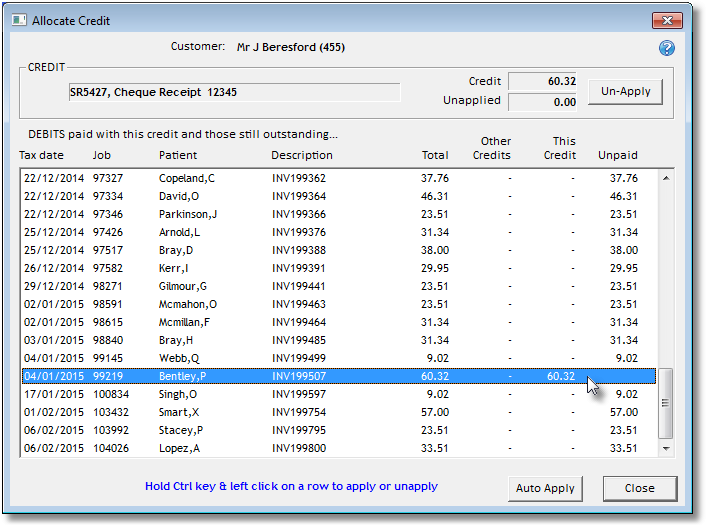
Notice that the credit matched the invoice exactly so the unapplied amount is now 0.00.
| • | Click Ok |
That's it.. On viewing the History window for this example account we now see a neat allocation history.
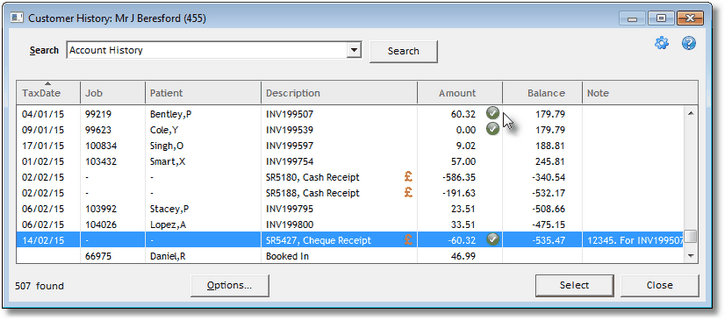
The Green ticks indicate fully allocated credits or debits. More about that later.
Re-allocating or un-allocating receipts
Click this image to view a video of this topic:
Using the same surgeon, Beresford, view his history then find the payment we added in the previous step, for £60.32.
Suppose we've decided not to allocate the credit to that job, and would rather allocate this to partially pay a higher value job. Right mouse click on the payment (ie. not the job) and select "Allocations".
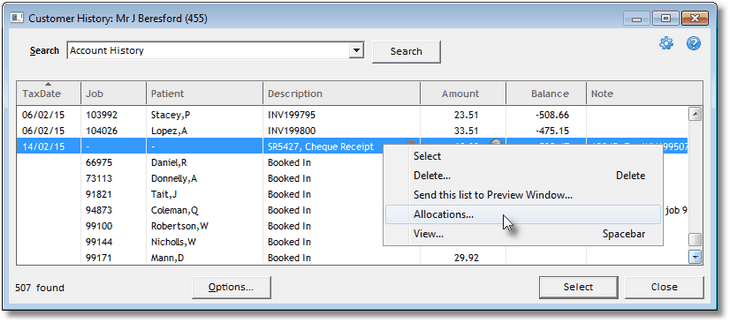
Click on the Un-Apply button to forget the allocation we specified earlier. After clicking un-apply, the unapplied amount is the same as the credit amount..

Now, hold down the CTRL key on your keyboard and select an outstanding invoice that totals more than £60.32 - or, if you do not see an invoice of more than £60.32, CTRL click on an invoice, then CTRL click on a second invoice to apply any outstanding amount.
Click the Close button to apply your allocations, then take a look at the history. Notice there is a green tick next to your payment, but there is an orange orb next to the invoice/s you selected.
Can you see what's happened here?..
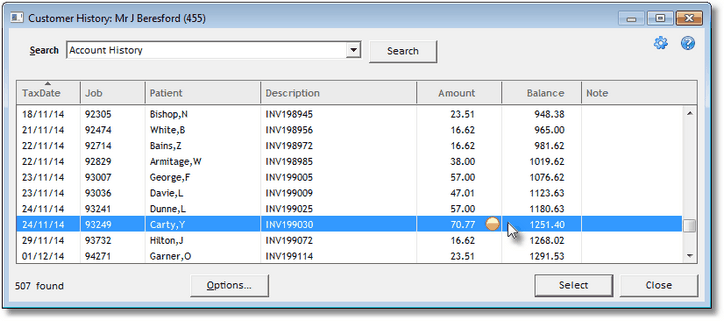
Yep, you've guessed it, the job's invoice has only been partially paid off. The half-shaded orange signifies a partially allocated transaction.
Giving a Refund or making a Debit adjustment
Click this image to view a video of this topic:
| • | Select a customer onto the Main Form |
| • | From the Customer menu, choose Make Refund/Debit.. |
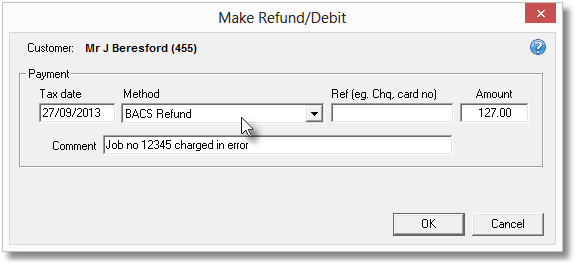
Enter the refund/debit details, choosing an appropriate 'Payment Method'. If you want the payment debit to appear on last month's statement, don't forget to back date the Tax Date.
| • | Click Ok |
That's it. Skip to the next Topic if you are clued up about book keeping, otherwise read on if you want to understand more about credits/remittances and debits/refunds.
You may be wondering if we are giving a customer a refund, why debit their account? Well think of it this way, it's the reverse of receiving money from them (a credit). Usually you won't be giving a refund in cash this way. If a customer has been overcharged or has not accepted an invoice for a bad job ( say £100 ) then you would simply raise a Credit Note and probably manually allocate it to the offending original job invoice. It's possible of course, that there'd be nothing to allocate to, in which case the £100 would go on as a 'credit on account' or as we know it, 'an un-allocated credit'.
If that customer doesn't have any job invoices to use up the credit, and perhaps requests the cash, it's then that you'd have to make a refund, give them the cash (or BACS payment), and record the Refund transaction in Transactor Lab Manager.
To clarify, a £100 credit note you raise means you owe the customer £100. If no other transactions are happening their account is now in Credit (£100 CR). If they ask for it in cash, you give a refund and debit their account (£100 DR). The two transactions balance out to zero.
Incidentally, notice there's no attempt to allocate these Refunds / Debits. That's because these are in the same polarity as Invoices, so they don't get allocated to anything. Later on credits will get allocated to them (either manually, or automatically).